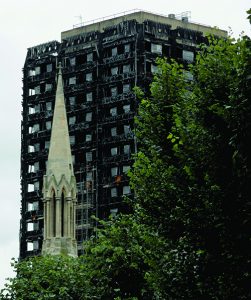Future for composite fire doors after Grenfell
Andrew Fowlds, Chair of the Association of Composite Door Manufacturers,discusses exclusively in Doors Active, Grenfell and composite fire doors: the fight to save an industry

The terrible fire that consumed a hitherto unremarkable 24-storey block of flats known as Grenfell Tower in Kensington, West London on 14th June 2017, has now served to rock the establishment of the British building and construction industry at every level. The 72 lives lost represent an unacceptable toll that will scar the lives of their friends and loved ones forever. The tragedy has shaken the construction industry to its core with the Grenfell Official Inquiry examining and laying bare every product and process used in the construction, refurbishment and maintenance of the building, including its regulatory standards and systems.
Creating doubt – Many have been found to be lacking, including some of the composite fire door sets used throughout the building for the majority of the 120 flat front entrances. A complete door set was removed by the Metropolitan Police and fire tested by the Ministry of Housing, Communities and Local Government (MHCLG). The tested product was found to fall short of the 30 minute fire resistance classification, failing at around half of its rating due to failure of the glazing. Since then the products of a further 7 manufacturers have also been tested and found to fall short of their rating which unfortunately created doubts about the whole composite fire door industry.
On 23rd June 2018, in response to demands by the MHCLG, the Glass & Glazing Federation (GGF) called a meeting of composite fire door manufacturers, including the Composite Door Manufacturers Association (ACDM), which was deemed to be the representative body for the sector.
A further, wider meeting took place on 2nd August that was attended by the GGF, ACDM and MHCLG but with a more comprehensive attendance by fire door set manufacturers and component suppliers, including others not members of any of the governing bodies present. At this meeting, it was agreed that the industry would henceforth only supply fire door sets ‘…which could demonstrate consistent furnace test performance to the appropriate standard from both sides of the door set. Supply of fire door sets which did not meet this criteria would be suspended.’ This was communicated to the industry through an announcement issued by the ACDM the following day.
The problem was that almost every composite fire door set on the market had been fire tested from one side only, this being the side of the door deemed by the test houses to be the most onerous for the fire test and the side where a fire was likely to start i.e. opening in towards the furnace. Their methodology was that historically fire tests performed on door sets opening away from the furnace had always performed better than on those opening in towards the furnace. Therefore if the most onerous side passes, then there was no need to test the other. However the Government proved this position was flawed. The first significant action by the ACDM, a body that had largely existed since its inception as a technical talking shop, was to bring the composite fire door industry to a halt.
Primary representative body – Elevated overnight to the status of primary representative body for the sector, the ACDM nonetheless acted decisively and authoritatively, within three weeks of the first meeting appointing a Task Force including the largest door blank suppliers and door set fabricators. Coinciding with the appointment of the Task Force, Andrew Fowlds, CEO of Distinction Doors Group, became Chair of the ACDM.
“Our first action was to oversee the effective suspension of a whole industry,” reflected Andrew. “But faced with some strong language by the representatives of the Ministry of Housing, we had little choice. We had to create a programme of re-testing in order to demonstrate compliance of basic GRP composite fire door sets under the watch of the MHCLG.”
The ACDM Task Force commenced a programme of weekly teleconferences with the MHCLG and fortnightly meetings in Whitehall, which included regular, detailed summaries to the Secretary of State at the MHCLG James Brokenshire MP, advising progress. Within a week of the announcement of the moratorium on fire door sales and against a backdrop of an agreement by the Expert Panel appointed to advise the MHCLG that existing installed door sets presented a ‘low risk’, the ACDM agreed to engage with Government experts to investigate a risk based approach to remedial actions needed in respect of fire door sets.
A test programme was agreed but an immediate problem was encountered: such was the intensity of the Inquiry into the Grenfell Tower tragedy that test laboratories were working flat out and ACDM had to ask MHCLG to release some of its own test slots to the door industry. “Within a fortnight of the announcement that GRP fire door sets were to be withdrawn from the market we had instigated a test programme to get the industry’s products back to market, fully tested and compliant,” recalled Andrew. “We had to manage the reputation of the composite fire door industry and, actually, the composite door industry per se.”
Trading Standards officials – Discussions also included Trading Standards officials, the body expected to enforce actions relating to fire door sets; the Local Government Association representing public sector landlords; and the National Fire Chiefs Council. By mid October ACDM had proposed a plan for the re-supply of GRP composite fire door sets to the market subject to the provision of the relevant bi-directional primary test evidence. “The intensity of discussions between so many parties was exhausting for all of us,” says Andrew Fowlds, “and was especially demanding because of course, we all had other responsibilities. But having made the commitment to get GRP composite fire door sets back to market we had to see it through.”
The weekly teleconferences between members of the ACDM Fire Door Task Force continued, as did the subsequent call to the MHCLG: “In mid October we also opened discussions with test body Exova, as we had to get a regime of re-testing underway as well as resolve the question of testing both sides of the door sets,” explained Andrew. “This was to bring all GRP composite fire door sets in strict alignment with the Building Regulations, which was the issue that brought all such products into question, even if they physically passed the fire resistance test on the most onerous side of the door. What had been deemed to be acceptable for years by all test houses was now at the core of the problem for almost all fire door set manufacturers with previously acceptable test evidence certificates.”
Submitted a plan – By early November, Andrew and the members of the Task Force had submitted a plan to the Secretary of State at MHCLG designed to allow composite fire door sets to re-enter the market, ending the moratorium. “We had succeeded in our first task, to get composite fire door sets back to market,” said Andrew, “because without products approved in accordance with Government requirements we could not begin to look at remediation and the review of the risk of thousands of installed composite fire door sets that have been shown to present vulnerability via testing. And of course, manufacturers and installers of these products had suffered enormously, many on the edge of survival.”
Remediation remains the key issue, with an unsubstantiated though widely quoted figure appearing in the popular press suggesting that 25,000 door sets are installed bearing the brands of the manufacturers originally named by the government. This is in addition to fire door sets that have passed their full 30-minute fire resistance testing but which have not been tested both sides. “This remains the greatest task,” says Andrew. “And whilst newspapers continue to criticise the government for not having implemented a plan to replace the door sets, it will be an enormous task even to get all parties talking together.
“This will also represent a substantial effort for the ACDM, which for those of us dealing with the issue on a day to day basis has been extraordinarily time consuming and at times, challenging. We have discussed whether this association, which was for so long primarily a device for technical experts to compare notes and prepare standards and issues of common interest, was able to continue to represent not just the interest of composite fire door manufacturers, but also of course the interests of composite door sets for all applications.
Put forward plans – “And,” continued Andrew, “the view of everyone involved is that ‘yes, we will’. And at the forthcoming Annual General Meeting we will put forward plans for ACDM not only to continue with this crucial campaign to protect our members and this industry, but that we will ensure that it enjoys the resources to protect and promote them effectively and successfully. I invite every company involved in the manufacture and sale of composite residential door sets to come and join us. We need the commitment of everyone in the composite door industry. We are mindful that the popularity of composite residential door sets should not be affected by the fire door problem,” added Andrew, “as there is early evidence that questions are being asked by homeowners that have picked up on the press coverage. This will be dealt with by the ACDM professionally and affectively. But we need everyone on board to create a strong and powerful voice,” he concluded.











